PART 2. «Implementation of the complex restoration of the Church of the Transfiguration of Kizhi Pogost in 2010»
 @kizhi
@kizhi
Introduction
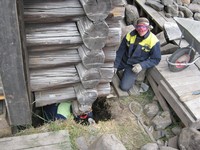
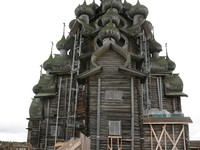
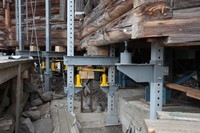
In 2010 the 1st stage of the complex restoration of the Church of the Transfiguration was continued.
The preparation work on sections I–II of the «Main Stages of Works on the Restoration of the Church of the Transfiguration on Kizhi Island and their Fulfillment vs.Time. 1999–2014» had been done by the beginning of the year. The work was described in details in previous reports (2003–2008). The works stipulated by items III.1–III.4 of the above mentioned scheduler had been done at the end of the year 2009.
At the beginning of the year 2010, the state of the restoration work of the Church of the Transfiguration (see Section III of the scheduler) was as follows:
- the porch was dismantled and the details were warehoused;
- the refectory was dismantled and their details are under restoration;
- the lifting system had been mounted, the debugging of the system for lifting, hanging up and suspension of the engineering restoration tiers of the Church had been done;
- the Church framework restoration tiers had been lifted and effectively clamped;
- the object was conserved for winter to preserve constructions, equipment and the monument elements.
In 2010 the work planned in Section III of the scheduler was continued and carried out according to the schedule. The report describes in details the course and results of the work carried out in 2010. The report is supplied with graphic materials and photos that provide insight into the progress and results of the work done.
Main Stages of Works on the Restoration of the Church of the Transfiguration on Kizhi Island and their Fulfillment vs.Time. 1999–2014. The situation described as to the end of 2010.
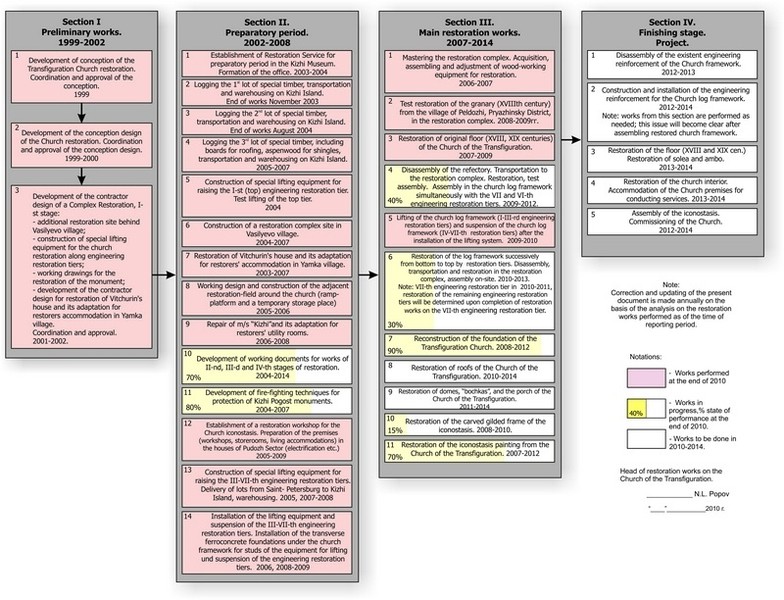
2.1. Monitoring of the lifted log walls condition and lifting equipment in winter period and spring after snow melting
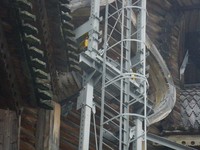
For the reason that the upper restoration tiers of the church were kept lifted and hanged up for winter 2010–2011, the instrumental monitoring for the condition of lifted log walls and the reliability of the lifting system was required for the period of cold winter 2010 and spring when snow was melting.
The professionals from the SLR «Strojreconstructsija» (the company developed the lifting system for log walls) were involved to this work. In concordance with the approved monitoring plan, the instrumental control of the possible deformations of the construction, details of log walls and lifting system had been done two times – in February and April.
In was mentioned in the given report, that:
- The results of the proof-of-principle work showed that load — bearing elements of the Church of the Transfiguration, metalwork for the lifting and fixation of engineering restoration tiers has not been deformed and are in the operational condition;
- Monitoring revealed the necessity of some additional measures to strengthen the existing lifting system by installation of 12 additional outdoor jack posts with crawls. The posts were mounted on north — west, south — west and south — east diagonal walls between +9,40 and +15,90 marks. The length of metal posts is increased for 7 m;
- Maintenance and service experience of the mounted metalwork for lifting shows that it is necessary to equip new outdoor posts on diagonal log walls with staircases from access boards to the top (+15,00 level). The staircases must have protection baskets and crossing platforms every 5 m. The guard platforms must be done at the post levels of +10,40 and +13,00 m to provide the safe work with jacks during the reassembling of log walls.
The suggestions mentioned in the above–mentioned report were accepted and implemented in 2010.
2.2. Provision of conditions for the WHC UNESCO – ICOMOS mission – 2010
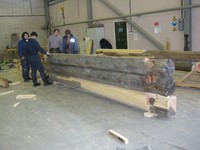
After the dismantling of refectory and preparation of the elements for restoration, it was necessary to develop criteria for evaluating log condition and studying the possibility of their restoration or replacement. It was also needed to develop restoration and repair approaches for historic timbers taking into consideration damage type and degree.
In this connection, the experimental restoration of the granary (built in the XVIIIth century) with the logs almost identical in degree of preservation and condition to those from the Church of the Transfiguration was implemented in 2008–2009. The restoration technology for logs with different types and degree of damage was tested as well as preliminary assembling of the log walls in the assembly department of the Restoration Complex and final assembly of the restored log walls on the original place.
The restoration results were summarized in the detailed scientific and technical report with conclusions and recommendations for the approaches to restoration of historic logs. This report was sent to WHC and ICOMOS for investigation and recommendations. After the analysis of this report by WHC and ICOMOS experts and taking into account our request, it was decided to perform an inspection of the conservation state of the Kizhi Pogost monuments and consider accordingly the issues of complex restoration of the Church of the Transfiguration in April 2010.
During the preparation for WHC–ICOMOS mission the experimental restoration of the refectory dismantled logs was done in the Restoration complex by the technique tested at the restoration of the XVIII c. granary. This was made in addition to the above mentioned monitoring of the Church of the Transfiguration structure elements and the lifting system.
2.3. Joint WHC UNESCO–ICOMOS mission visit to Kizhi, April 2010
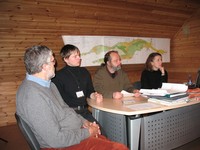
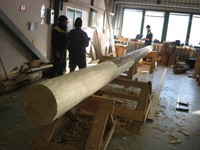
Joint WHC — ICOMOS mission worked on Kizhi on April 5–7, 2010. The main topics of the mission and Russian experts' work are as follows:
- The reliability and stability of the systems for lifting, hanging up and fixation of the restoration tiers installed in the Church of the Transfiguration were carefully studied during the mission work and by the experts on — site. During the discussion, the correctness and effectiveness of the accepted and implemented project decisions were confirmed again.
- The sequence of the lifting procedures during the process of logs dismantling was discussed.It was noted that the technology for sequential lifting of the three upper restoration tiers from the level +11,50 to +37,00 with the subsequent dismantling of the unloaded lower part starting from the foundation up is not known in the traditional restoration practice yet. During the consideration into the process details that ensure this work order, the project decisions and practical experience were thoroughly examined by experts and approved in whole. Expert remarks and suggestions expressed during the discussion were taken into account and became the basis for the correction of the project within technical and field supervision in 2010.
- The complicated problems of repair and restoration of logs were discussed. The refectory logs were restored in advance, prepared and demonstrated to the mission experts. Having examined and analyzed the restored logs, the experts noted the excellent workmanship of the restorer carpenters and nevertheless mentioned the shortcomings, stipulated by insufficient knowledge about the natural dynamics of repairing large timbers, large number of patches in one log and recommended the limitation of using the glued wood patches. According to their opinion, the number of patches in the log must be less than two (three patches as an exception).
- The Mission recommended that the training course for the carpenters in wood dynamics, traditional carpentry and application of conservation principles is needed to avoid splitting, cracking, and other failure of repairs.
- The mission experts had developed and presented to the museum «Guidelines for selecting log repair at Kizhi Pogost».
During the Mission work the problems that accompany the restoration of a unique monument were discussed, and the exchange of opinions took place.
At the final stage of the discussion, the Mission recommended to inspect the Site every two years, instead of annual inspection as it was done usually. It indicates the correctness of the chosen restoration approach and that the World community believes in the success of the project implemented by the existing restoration team.
2.4. Training of the Kizhi open-air museum carpenters
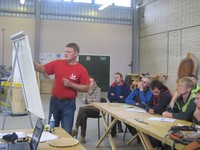
According to the WHC–ICOMOS Mission recommendations, the 72–hours training course for carpenters was organized in the Kizhi museum in summer 2010.
The lectures of the Course covered the following topics:
- wood structure; physical, chemical and strength properties;
- guidelines for the restoration of wooden architectural monuments;
- traditional carpentry.
Workshops were devoted to diagnostics of wood defects, restoration training, fire–safety of the monuments, etc.
The program of the training course is attached.
See also:
II.10 «Development of working documentation for the 3d and 4th stages of the complex restoration design of the Church of the Transfiguration»
Elaboration of working documents for completion III and IV stages of Complex Restoration was going on. Chief designer «Spetsprojectrestavratsiya», Saint–Petersburg, continued project works in collaboration with subcontracted organizations.
The work concerns correction of the project during reconstruction of the rubble concrete strip foundation with consolidating reinforced concrete belt located under the church and the refectory, location of electrical and fire–safe equipment compartments in the basement, section concerning the restoration of the VIIth engineering restoration tier including the element inspection, drawings and design drawings.
The government contract is valid until December 2011, that's why the development of the design drawings for every dismantled element of the VIIth restoration tier is going on. In 2011 the analysis of present condition of loaded historic log wall elements and their reliability evaluation is planned.
Implementation of the 1st stage of the Complex restoration of the Church of the Transfiguration (Section III of the scheduler)
The Complex restoration of the Church of the Transfiguration (Section III of the Scheduler) was continued in 2010. As it was mentioned above, the works on items III.1–III.4 were implemented in 2008–2009, therefore the items of the next section were implemented in 2010.
In concordance with the planned volume of restoration work, the tender documentation was worked up and the competitive tender for the restoration contract was carried out. To provide good results and continuous running duty, the contract was concluded for two years – 2010 and 2011.
As a result of the tender SKF «Alekon» was awarded the state contract.
It simplified the implementation of the contract in 2010, because the «Alekon» company had big experience in preliminary restoration of the just that very monument – the Church of the Transfiguration and the company employees were acquainted with the Church structure and the documentation on its Complex restoration in details.
Taking into consideration big volume and complexity of the work, engineering supervision was done by «Stroyreconstructsija» Co Ltd (St.Petersburg) as long as this organization is the project author for foundation, lifting and suspension systems for the Church of the Transfiguration.
Field supervision was done by Chief designer «Spetsprojectrestavratsiya», Saint-Petersburg.
III.4 «Restoration of refectory elements dismantled in 2009»
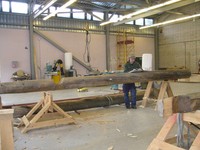
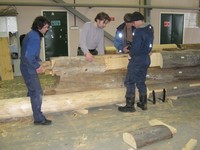
Structural elements of the refectory dismantled in 2009 were inspected and restored in 2010. The work was done step–by–step and included the following:
- Inspection of every structural element, making drafts and working drawing for their restoration. The work included the following:
- description of a structural element: making sketches, overall and fragment photofixation before restoration, patching of damaged zones and photofixation after restoration;
- making drafts and working drawing for their restoration.
- Refectory structural elements restoration included the following:
- Extracting destroyed parts from structural elements;
- Making and fixing of insertion, crowns and patches.
The material for the insertions was selected form the sound part of logs dismantled from the refectory in 2009 in case the whole log had unsatisfactory quality and could not be re–installed to the structure or from special timber stocked in 2004. When selecting material, they took into consideration wood moisture content, physical characteristics and condition of the wood surface.
Fastening insertion pieces on the restored elements was done with adhesive composition «Клейберит ПУР 501» (Germany) using additional pegs of birch wood, dowels or self–tapping screws if necessary.
All pieces, inserted in refectory structural elements were marked by «ПЦ» label (Carpenter Center) with index, date and carpenter's name. The label was burned or written by special pencil.
The restored elements of the refectory are stocked in the storage area, detailed tables and maps of stacking are made.
About 21% of the structural elements (52 of 242 elements) had been restored as of the 1st of December, 2010. The work is going on. In future restoration of the refectory structural elements will be continued simultaneously with the logs of the VIIth restoration tier dismantled in 2010.
III.5 «Lifting log walls (I–III restoration tiers) and suspension (IV-VI restoration tiers) after completing the lifting system»
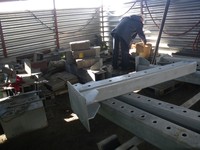
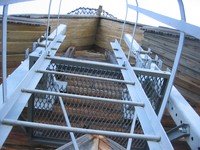
Lifting and fixing of the I–III engineering restoration tiers was implemented in 2009 and revealed the necessity to upgrade the lifting equipment so that to improve the restorers working conditions and fire safety of restoration. The designer put forward the proposals and developed technical documentation for production and installation of additional posts with staircases and crossing platforms on diagonal log walls from +9,40 to +15,90 levels (Fig.). Manufacturing and installation of the equipment was done by SKF «Alekon» Co Ltd in August 2010. The similar metalwork on north–east wall was installed in 2009.
After installation of the additional metalwork the I–III restoration tiers were lifted to design marks again and fixed. As a result, the weight of lifted and suspended restoration tiers (appr. 160 ton) was shifted onto metalwork (installed in 1980). Therefore the weight of the unlifted log walls (appr. 270 tons) significantly decreased and the estimated load to the new foundation during the dismantling of the IV–VII restoration tiers decreased as well.
III.6 «Dismantling, transportation and restoration in the Restoration Complex, on-site assembling»
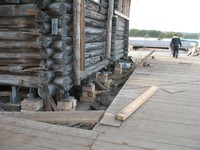
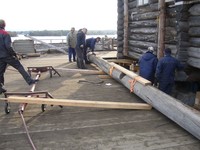
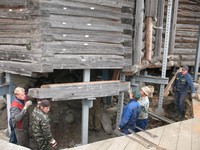
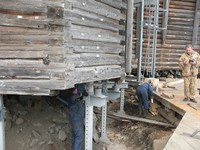
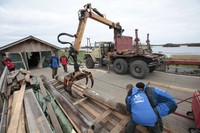
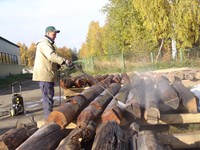
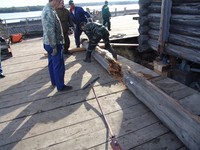
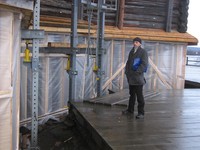
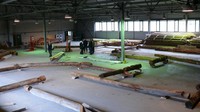
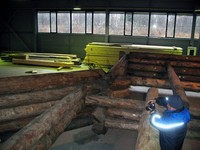
1–2. The lower log sets of the church log walls were dismantled along the perimeter
According to the technological project, the dismantled logs had to be set successively on the constructed belt foundation under the ground level in order to disassemble log sets of the lower restoration tier. 65 adjustable legs installed along the Church perimeter between the foundation and lower logs with gaskets were used for this purpose. After the dismantling of 2 or 3 lower log sets the weight of log walls is shifted to the transverse beam of suspension system, and then adjustable legs are removed.
When the underground part of rubble concrete belt foundation was built and strengthened, adjustable legs were installed on the foundation along the perimeter and brought to the lower log set. After that adjustable legs were removed in consecutive order starting from the altar giving a chance to remove logs from the wall through the opening. Then logs were removed from the wall and delivered for restoration. When the lower log was removed from the wall, the adjustable legs were brought to the log in the upper log set.
These manipulations were repeated until the lower part of the tier could be placed on the transverse beam and console of the system for the log wall suspension. Since that time the weight of the intact part of the restoration tier was shifted to the suspension system. The other log sets of the VIIth restoration tier and ground floor beams were removed by rearranging movable cross–beams of log walls in consecutive order. 250 logs were dismantled and delivered to restoration workshop. The height of the dismantled part is 2,5 m in average. The remaining log walls were securely adjusted on the existing supporting structure and systems for lifting and suspension.
3. Logs were transported to the Restoration Complex, cleaned, washed up, air–dried and stacked before restoration
Dismantled logs were placed on the site platform, then put on a special transporting carriage and transferred to the temporary storehouse by wooden technological bridging. Then they were carefully moved to the Restoration Complex by timber lorry with a hydraulic manipulator. In order to prevent the damage of historic timber during the transportation, loading and unloading, the timber lorry trailer was equipped with special felt–covered cradle and a clamp system of the hydraulic manipulator was covered by special soft material.
Logs delivered to the Restoration Complex were unloaded to a washing ramp, then they were washed by water jet from high–pressure device «Karcher» and air–dried during 2 or 3 days (depending on weather conditions). After washing and air–drying logs were transported to the indoor store–house of the Restoration Complex for temporary storage on special single–layer stacks equipped with felt–covered cradles.
Historic logs were carefully inspected, photofixed and measured during storage. Inspection of logs removed from the VII restoration tier was made during the dismantling and storage and this inspection revealed extremely bad condition of the majority of the logs. The obtained results were much different from that obtained before the dismantling and were unexpected for restorers. The logs protected from environmental factors (located in the refectory shade or beams in the basement) were in better condition.
This fact supports the validity of the restoration method used because the disassembly of a structure tier by tier enables to restore historic logs with high efficiency provided that the quantity of those logs being restored at a time is not large; and also this method enables to select the restoration technique that suits best to preserve maximum historic material.
4. Covering of a missing part in Church walls after the disassembly of the lower (VIIth) restoration tier
The cover made of reinforced poly–film mounted on a wooden frame was made in line with working project on completion of restoration in 2010. It was done to protect the reconstructed rubble concrete foundation, structural openings that appeared after the dismantling of lower logs as well as electrical equipment, remote control and fire–alarm systems installed in the Church from snow and rain. Small roofs were built along perimeter of the log walls to protect them against melted snow and rain–water.
5. Pre-restoration test–assembly of the restoration tier in the assembly workshop of the Restoration complex
The log walls of the Church of the Transfiguration have been exposed to different factors for nearly 300 years and got significant deformations. This affected its present outline. The research made before and during the Church dissassembly revealed declinations from the original location of log walls on the historic foundation. The lower log sets were moved from their original places as shown by the beam ends shifted considerably (more than 10 cm and up to complete dislocation). Significant deformations are observed in a vertical section of log walls, which results in the declination of the Church vertical axis to north–west and defect of the historic indent up to 40 cm in height.
In order to determine the ways of eliminating floor declination, the preliminary assembling of non–restored elements (5 preserved log sets from the VII restoration tier) was performed in the assembly workshop of the Restoration Complex. Vertical and horizontal declinations were estimated as a preliminary which made it possible to place log sets in the way of original outline of church walls and to set the floor horizontal indent on the upper log set.
The assembled part of historic log walls will be demonstrated to WHC–ICOMOS mission experts during their visit in February 2011. During the next inspection of WHC–ICOMOS mission restorers and designers are planning to discuss and approve methods of eliminating floor declination and logs restoration.
Restoration of the logs from the VIIth tier and experimental assembly of the tier after restoration will be done after the decisions are agreed upon and then it will be presented to the joint commission.
III.7 «Reconstruction of the Church foundation»
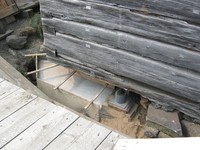
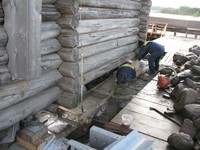
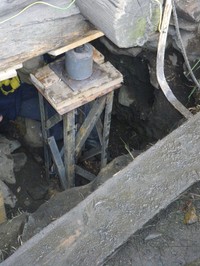
The underground part of the belt foundation was built in August–September 2010 in line with 255/06–КМ project and working project.
The D part was built of rubble concrete in parts between existing transverse foundations for the equipment intended for suspension of the engineering restoration tiers which works as a counterfort and is a part of the Church foundation.
The depth of foundation bed along the perimeter is more than 1,65 m from day surface.
Rubble stones were poured in the foundation by the use of pervibrators. Stones were first carefully selected and prepared: stones were collected from the Church disassembled foundation and Pogost territory, sorted, calibrated and washed.
The upper part of the foundation was leveled for 40 cm below daylight surface along the perimeter, at the same time anchors were set for connecting the reinforced concrete belt. When the foundation strengthened up to the designed values, boxing was removed and pockets were filled with consolidated sand.
III.10 «Restoration of carved gilded frame of the iconostasis»

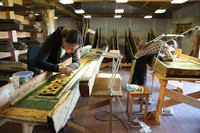
In 2010 restoration of carved gilded frame of the iconostasis of the Church of the Transfiguration was continued.
Conservation of gilded surface of the lower tier of the iconostasis started in 2009 and was finished in 2010. The contractor was Moscow art research and restoration directorate.
In April–May 2010, this organization won the competitive tendering for the restoration of the Prophets tier of the iconostasis. Working contract covenanted not only conservation of gilded layer of the tier but also the restoration of carvings. In 2010 significant part of gilded layer was restored and reconstruction of lost carved parts was started.
Iconostasis monitoring system observes the state of preservation, analyzes obtained data and uses analytical results for the further preservation. In 2010 some works were done on this subject.
Monitoring of the preservation state and analysis of the obtained data were continued.
Museum art–restorers continued a detailed examination of the preservation state of all dismantled parts and fragments of the iconostasis.
In addition, restorers from St. Petersburg OOO «Atrium» Co. Ltd were contracted to examine carefully the preservation state of the Deisis tier of the iconostasis frame. They made technical, technological and chemical analysis of gilded surface. The obtained results significantly supplemented previous research made by the State Russian Museum and Restoration department of Bavaria monuments conservation directorate in 1990.
«Measures to ensure safety of the Kizhi pogost ensemble…» (decree N 1633–p of Russian Federation government on 07.11.2008) stipulated «Creation of electronic data base for monitoring the iconostasis of the Church of the Transfiguration». The works are to be completed in 2010 in line with this document. During the program implementation, the Kizhi open–air museum purchased «Restoration» programming module to enhance capabilities of KAMIS software which unites the museum databases on historic and cultural monuments. In 2010, «Restoration» programming module was adapted to the specific character of the museum and creation of a special database has been started since the end of the year. It should be mentioned that this software needs to be debugged and tested.
The financing for restoration of the iconostasis is guaranteed and will be continued in 2011.
